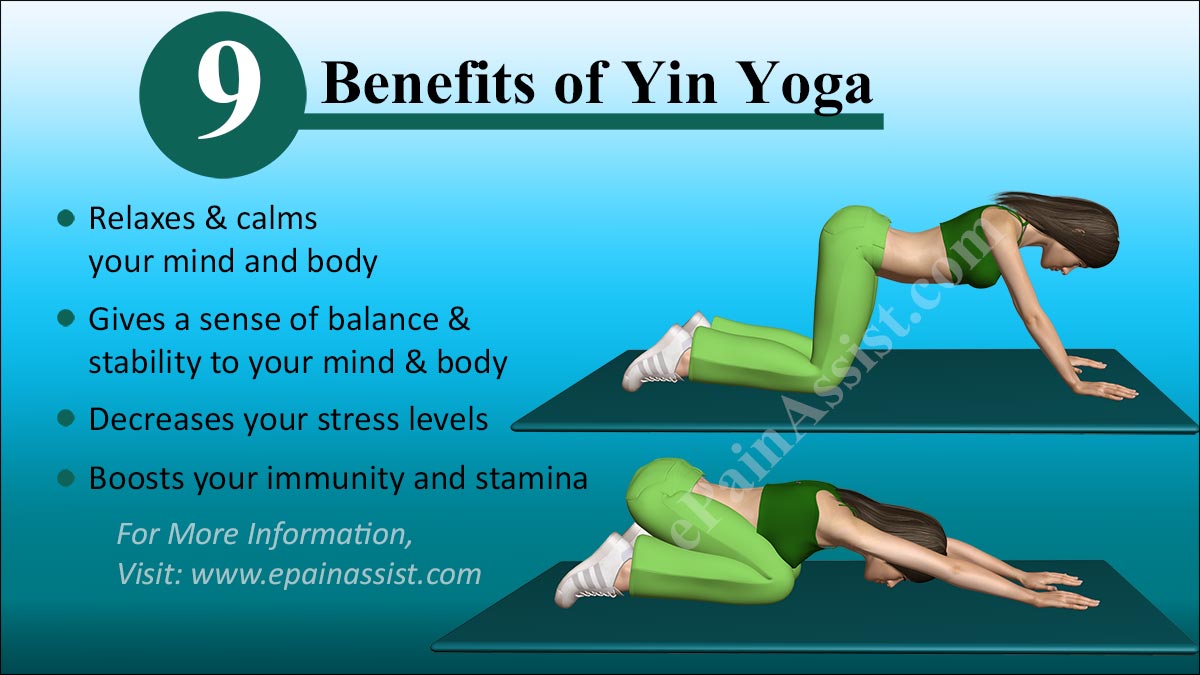What is Yin Yoga?
Yin Yoga is a form of yoga, which is slow in pace when compared to other styles of yoga. The yoga postures or asanas are held for longer periods of time (generally 5 mins or more). Some experts consider Yin yoga to be the oldest type of Hatha yoga. Yin Yoga is not that common as other yoga styles and many people are not aware of it. This yoga style targets the connective tissues present deep in the body and the fascia covering the body and stabilizes the flow of energy throughout the body.

What is The Origin of Yin Yoga?
Yin Yoga is founded on the Taoist theory of Yin and Yang, which are opposite and balancing beliefs in nature. Yin is the stable, feminine, cold, passive and moving downwards; whereas Yang is the changing, masculine, active, hot, and moving upwards. The moon is thought to be Yin and the sun is thought to be Yang. The Yin yoga concept is as old as centuries and it is found that in ancient texts there are only 16 postures in Yin Yoga; whereas there are many more asanas practiced in today’s yoga. The Yin Yoga asanas were naturally more “yin” in nature to advance meditation along with prolonged periods of sitting and doing pranayama.
How Do The Postures of Yin Yoga Differ From Other Yoga Styles?
The postures in Yin Yoga are more passive and are held for longer time. They are done commonly on the floor. The special thing about Yin Yoga is that you are told to relax in the posture and to try to make your muscles more pliable and move towards the bone. Yin yoga gives you a deeper connection with your body. The postures are commonly held for 5 minutes or more, sometimes even up to 20 minutes for one posture. The time expended in these postures is like how you spend your time during meditation.
What is The Difference Between Yin Yoga and Yang Yoga?
In human body, the comparatively stiff connective tissues, such as tendons, fascia, ligaments are yin; whereas, the more mobile, active and flexible blood and muscles are yang. The passive yoga asanas are considered to be yin and the active yoga asanas are yang, as they stimulate the muscles and produce heat. The main difference between a Yin Yoga and Yang Yoga is that Yang Yoga involves constant rhythmic movements; whereas, Yin Yoga involves working with traction or putting some pressure on the joints so that the deep layers of the connective tissues are also affected.
Yin Yoga helps by freeing up the stiff connective tissue capsules surrounding the joints and muscles. This stiffness increases with age and the result is limited mobility for an individual. The lubrication of the joints also dries up leading to brittleness seen with old age. Yin yoga helps you by targeting the joints, capsules, connective tissues, muscles so as to increase your suppleness and flexibility of your body which in turn makes you feel and look young.
How Does Yin Yoga Work?
Yin yoga not only has physical benefits, but also has mental, emotional and psychological benefits too. As mentioned above, yin yoga requires the poses to be held for longer periods of time when compared to other yoga styles. This helps you in getting touch with your inner self and brings about calm and peace with meditation. Yin yoga soothes the nervous system, calms the mind and allows the body to return to its natural healthy heart rate.
The poses or asanas of Yin Yoga put moderate pressure/stress to the connective tissues (tendons, fascia, ligaments) in order to increase circulation in the joints and enhance flexibility. Yin Yoga poses are structured to improve the flow of qi, which is the understated energy which runs via the meridian pathways in the body. Enhanced qi flow is thought to benefit organs, boost immunity, and increases your emotional well-being.
What Are The Benefits of Yin Yoga?
- Relaxes and calms your mind and body.
- Gives a sense of balance and stability to your mind and body.
- Helps in regulating the energy levels in your body.
- Increases flexibility in the connective tissue, particularly at the joints and hips. Increases the production of lubrication at the joints; hence protecting them.
- Decreases your stress levels.
- Boosts your immunity and stamina.
- Helps with medical problems such as migraines and TMJ dysfunction.
- Increases your ability to deal with stress and anxiety.
- Prepares you for Yang yoga.
So in conclusion, Yin yoga does wonders for ageing people, as it helps in increasing the joint flexibility which is extremely helpful as you age. As mentioned before, Yin Yoga allows you to get in touch with your inner self, feelings, and emotions, which cannot be done in an otherwise fast paced yoga. Yin yoga is commonly used in programs dealing with addictions such as alcoholism, eating disorders, smoking, anxiety, ADHD and trauma. Yin yoga helps to calm your mind, increase your flexibility and trains you to sit calmly in one position for long periods of time.
